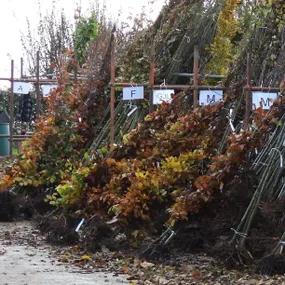Green Beech Large Trees

The details
- Native. Big, spreading tree to 35m
- Sizes: Saplings & Big Standards
- Requires good drainage.
- Bareroot Delivery: Nov-March
- RHS Award of Garden Merit
Recommended extras
Description
Fagus sylvatica: Green Beech Standard Size Trees
Common Green Beech is a large, semi-native tree that makes an excellent park or woodland specimen. If it is grown out in the open, it will develop a broad, rounded canopy and the tree's trunk will usually divide into thick, smooth branches quite low down. In a forest, it will maintain a single straight trunk and the canopy will be much narrower.
Beech is often called majestic and it well deserves the title. It is a big, spreading, muscular tree with well-formed branches and smooth grey bark that is rippled in places. Mature trees will cast quite dense shade underneath them during summer. The wind pollinated flowers are not really visible, and are a good pollen source for bees. The nuts that ripen in autumn are eaten by pigs and many small animals, although horse owners should not allow their horses to eat them. Beech looks beautiful in autumn, when the grey bark highlights the russet brown leaves.
Fagus sylvatica should reach a height of about 35 metres.
Standard trees are the largest size that we deliver; you can also buy younger Green Beech saplings here.
Browse our range of beech trees or all our garden trees.
Features:
- Lush green summer leaves, lovely russet autumn colour
- Smooth grey bark
- Good for bees & wildlife
- Not recommend for horse paddocks
- Bareroot delivery only: Nov-March
- To 30-35 metres
Growing Green Beech
It is suitable for any soil type as long as the drainage is good, and it tolerates some shade while young, as long as it can grow up into full sun. If your soil is damp or waterlogged in winter, Hornbeam looks similar and is a better choice.
Did You Know?
In the past, beech trees were prized by pig farmers, who would fatten their herds up for winter on the fallen beech nuts, known as mast. Humans can also eat the nuts, although they are pretty bitter. The oil of mast can be used for frying and for lamp oil. Beech wood is great for burning and while the timber isn't tough enough for outdoor or structural uses, it makes good quality indoor furniture.
Beech is a European tree that is probably not a true native in Britain; modern evidence suggests that it was not growing here before the formation of the Channel, and Stone Age humans might have introduced it from the mainland. Whatever the case, it is widely naturalised in Southern Britain and over 80,000 hectares of woodland are classified as being predominantly made up of beech.
The Whomping Willow in the Harry Potter films was, with added computer graphics, based on a 400-year-old beech tree known as the Queen Beech in the woods of Frithsden Beeches, Hertfordshire. This striking old tree was coppiced for firewood centuries ago and for the last 200 years it has been left alone, so it has a massively thick trunk and an imperious head of branches, several of which are as big as a mature tree.
Beech trees were perhaps best employed by Capability Brown, who used their vast and elegant form to punctuate parkland and to form great silvery-grey columns when grown in more confined woods.
Standard trees are measured by their girth in centimetres 1 metre above ground level: their trunk's waist measurement. Unlike sapling trees and hedge plants, standards aren't measured by their height, which will vary quite a bit both between and within species.
So, a 6/8cm standard tree has a trunk with a circumference of 6-8cm and an 8/10 standard has a trunk 8-10cm around. This measurement makes no difference to the tree's final height.
On average, standard trees are 2-3.5 metres tall when they arrive, but we cannot tell you precisely how tall your trees will be before we deliver them.
Planting Instructions
Notes on planting Green Beech trees:
Green Beech trees will grow well in any well drained soil, including chalk. They are quite shade tolerant and suitable for exposed locations.
They will not grow well if the site is damp - hornbeam is often used instead of beech on wet soil.
Prepare your site before planting:
It is good to dig over the site where you plant a tree several months in advance. Kill the weeds first: for tough weeds like nettles, brambles and ground elder, you will usually need a weed-killer to get rid of them. When you dig the soil over, remove stones and other rubbish and mix in well rotted compost or manure down to the depth of about 2 spades.
Watch our video on how to plant a tree for full instructions.
Remember to water establishing trees during dry weather for at least a year after planting.
Tree Planting accessories:
Prepare your site for planting by killing the weeds and grass with Neudorff WeedFree Plus.
You can buy a tree planting pack with a wooden stake & rubber tie to support the tree and a mulch mat with pegs to protect the soil around the base of your tree from weeds and drying out.
We suggest that you use mycorrhizal "friendly fungi" on the roots of all newly planted large trees: if your soil quality is poor, we strongly recommend it.
You can also improve your soil with bonemeal organic fertiliser and Growmore.

 hero Image 1.webp)
 hero Image 1.webp)
 leaves Image 2.webp)
 nuts Image 3.webp)
 trunks Image 4.webp)
